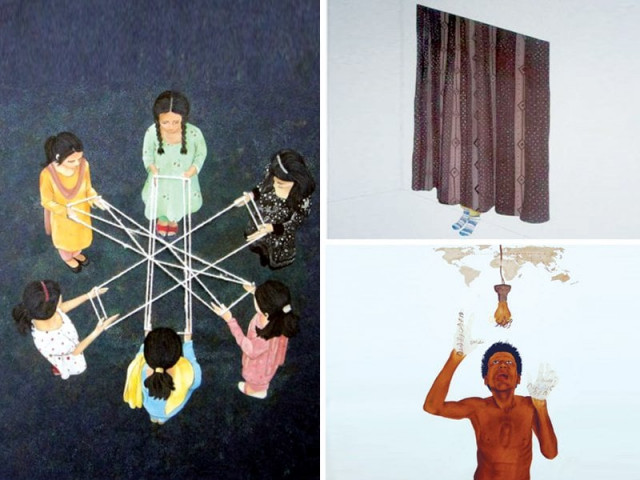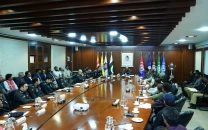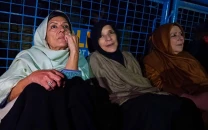Meaningful art: Reflection on Pakistan’s socio-political predicaments
Works of two artists complement each other.

The exhibition displays socially and intellectually motivating work by two young artists. PHOTO: THE EXPRESS TRIBUNE
But the global political conversation in Faraz Ali’s paintings and the nostalgia of childhood games in Irum Khokhar’s miniature pieces are, in fact, strangely interconnected.
Taken together, the paintings attempt to locate the answers to Pakistan’s present-day socio-political predicaments at the intersection of international politics and the social effects of the 21st century’s technological onslaught.
The exhibition will be inaugurated by Argentinean Ambassador Rodolfo Martin Saravia on Monday and the show will remain on display till June 10.
Ali’s work reflects on regional and global politics in the post-9/11 world in a way that draws audiences into a conversation.
The central character of each painting is a different semi-naked, brown-skinned man, caught in different postures on the canvases. The characters’ facial expressions, though resembling illustrations, are detailed and finely drawn.

Ali, a graduate of Indus Valley School of Art and Architecture, declares his political statements through interplay of these human characters with objects that symbolise abstract ideas.
“The work is laid in combination of innate insanity and innate common sense,” Ali says in his statement.
In his paintings, he uses images of a bulb, Afghani kettles and a fish to show hope, regional conflict and freedom respectively. World maps in some paintings add context and reflect the US intervention in the region.
In one painting, he shows a brown man, his private parts covered with a garment fashioned out of a US flag, holding a gun and a kettle from which a cartoon genie has emerged. Ali believes wars are fought to control resources and the genie and a couple of dollar bills suspended in mid-air near the man’s feet represent the financial gains that arise from conflict for certain lobbies.
“The expression does not reside in the passion which lights a face or is asserted in a violent movement. It is in my picture: in the area occupied by the body, in the space surrounding them.”
On the other hand, Khokhar’s modern miniature paintings are a nostalgic trip for the ‘90s generation. She recreates memories by showing playground games and children’s activities such as hide-and-seek, “paper fortune teller,” paper planes and playground rides.
Khokhar said she was compelled to revisit her own childhood memories because of the way technology has captured the daily activities of children these days.
“Today’s children are so tied up with the electronic media and video games that outdoor activities have almost vanished,” she said.
In one intricate painting, she shows a bird’s eye view of six girls playing a popular string game called “Cat’s Cradle”. Her attention to detail and the novel idea of attaching actual pieces of strings to the painting’s surface give Khokhar’s image an original tactile feeling.
Khokhar used the actual-object technique in other paintings as well, such as around 20 paper fortune tellers, in different states of opening and closing, on a white background with light sketching in another.
Nageen Hyat, the director of Nomad Gallery, said the paintings by the two artists apparently contrast with each other but also connect to give a picture of our present-day experience.
“On one hand, you have a series of paintings that is intellectually important and on the other, you have pieces that are socially relevant,” Hyat said. “(Their work) reflects the imbroglio of the War on Terror and issues emanating from personal discourse and their living experiences.”
Published in The Express Tribune, June 3rd, 2013.



















COMMENTS
Comments are moderated and generally will be posted if they are on-topic and not abusive.
For more information, please see our Comments FAQ